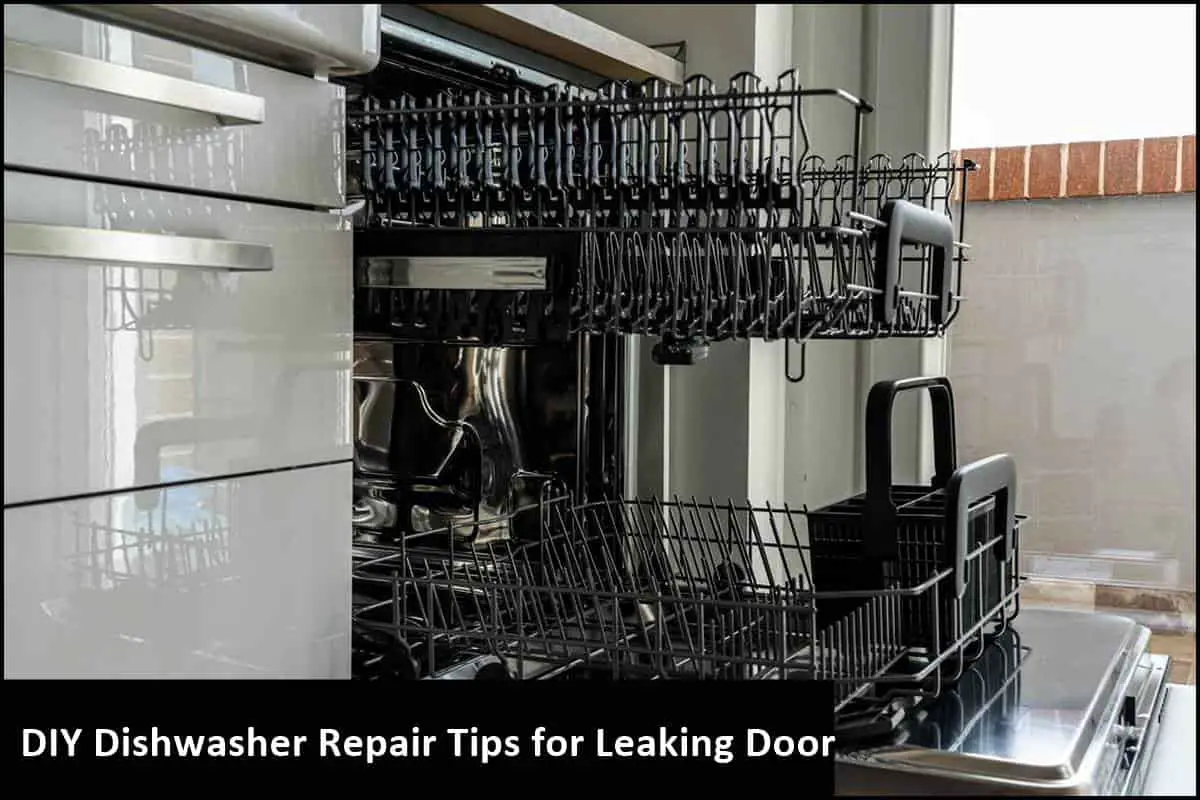A leaking dishwasher door is a common problem that can cause water damage to your kitchen floor and cabinets. If you’re experiencing this issue, don’t panic. There are several DIY repair tips you can use to fix the problem and save money on costly repairs.
Identifying the source of the leak is the first step in fixing a leaking dishwasher door. One common cause of a leaky door is a damaged or worn-out door gasket. Other potential causes include a damaged door latch, a clogged air gap, or a faulty water inlet valve. Once you’ve identified the source of the leak, you can gather the tools and materials needed to fix the problem.
With a few basic tools and some DIY know-how, you can repair a leaking dishwasher door in no time. In this article, we’ll provide a step-by-step repair guide, preventative maintenance tips, and troubleshooting advice to help you fix your dishwasher and avoid costly repairs.
Identifying the Source of the Leak
If you notice that your dishwasher door is leaking, don’t panic. There are a few things you can do to identify the source of the leak and fix it yourself. Here are some simple steps to follow:
Door Seal Inspection
The first thing to check is the door seal. If the seal is damaged, it can cause leaks. Inspect the seal for any cracks, tears, or signs of wear. If you find any damage, you should replace the seal. You can purchase a new seal from a hardware store or online.
Float Switch Check
Another possible cause of a leaking dishwasher door is a faulty float switch. The float switch is responsible for regulating the water level in the dishwasher. If it’s not working properly, it can cause the dishwasher to overfill and leak. To check the float switch, remove the bottom rack of the dishwasher and locate the switch. It’s usually a small, round device that’s attached to the tub. Check that the switch moves up and down freely. If it’s stuck, you may need to clean it or replace it.
Spray Arm Assessment
A clogged or damaged spray arm can also cause leaks in your dishwasher. The spray arm is responsible for distributing water throughout the dishwasher during the wash cycle. If it’s not working properly, water can leak out of the dishwasher door. To check the spray arm, remove the bottom rack of the dishwasher and inspect the arm for any damage or clogs. If you find any issues, you can clean the arm or replace it if necessary.
By following these simple steps, you can identify the source of the leak in your dishwasher door and fix it yourself. If you’re unsure about any of these steps, it’s best to consult a professional for assistance.
Tools and Materials Needed
When it comes to repairing a leaking dishwasher door, having the right tools and materials is essential. Here are the items that you will need:
Tools
- Screwdriver (Phillips and flathead)
- Pliers
- Wrench
- Socket set
- Putty knife
- Level
Materials
- Dishwasher door gasket
- Dishwasher cleaner
- Silicone sealant
- Replacement door latch
Having these tools and materials on hand will make the repair process much smoother and efficient. In addition to these items, it is important to have a basic understanding of how your dishwasher works and the parts that make up the door. This knowledge will help you identify the problem and determine the best course of action.
Before you begin any repairs, be sure to turn off the power to your dishwasher and shut off the water supply. This will ensure your safety and prevent any further damage to your appliance.
How to fix a leaking Dishwasher Door
If you are experiencing a leaking dishwasher door, don’t panic. You can fix this problem yourself without calling a professional repair technician. In this guide, I will provide you with step-by-step instructions on how to repair your dishwasher door.
Replacing the Door Gasket
The door gasket is the rubber seal that runs around the perimeter of the dishwasher door. Over time, this seal can become worn or damaged, causing leaks. To replace the door gasket, follow these steps:
- Turn off the power to your dishwasher by unplugging it or turning off the circuit breaker.
- Open the dishwasher door and locate the old gasket. It should be attached to the door with screws or clips.
- Remove the old gasket by unscrewing the screws or unclipping it from the door.
- Clean the area where the old gasket was attached with a damp cloth.
- Install the new gasket by attaching it to the door with screws or clips.
- Close the dishwasher door and turn on the power. Run a cycle to test for leaks.
Adjusting the Float Switch
The float switch is a small device located in the bottom of the dishwasher that controls the water level. If the water level is too high, it can cause leaks. To adjust the float switch, follow these steps:
- Turn off the power to your dishwasher by unplugging it or turning off the circuit breaker.
- Remove the bottom rack of the dishwasher to access the float switch.
- Check the float switch to make sure it moves freely up and down.
- Adjust the float switch by turning the adjustment screw located on the side of the switch.
- Replace the bottom rack and turn on the power. Run a cycle to test for leaks.
Fixing the Spray Arm
The spray arm is responsible for distributing water throughout the dishwasher. If it becomes clogged or damaged, it can cause leaks. To fix the spray arm, follow these steps:
- Turn off the power to your dishwasher by unplugging it or turning off the circuit breaker.
- Remove the bottom rack of the dishwasher to access the spray arm.
- Check the spray arm for clogs or damage. If it is clogged, clean it with a toothbrush and warm, soapy water.
- If the spray arm is damaged, replace it with a new one.
- Replace the bottom rack and turn on the power. Run a cycle to test for leaks.
By following these simple steps, you can fix your leaking dishwasher door and save money on repair costs. Remember to always turn off the power to your dishwasher before attempting any repairs. If you are unsure about any of these steps, consult your dishwasher’s user manual or contact a professional for assistance.
Preventative Maintenance Tips
As a DIY enthusiast, I know that prevention is always better than cure. And when it comes to dishwasher repair, this is especially true. Here are some preventative maintenance tips that can help you avoid a leaking dishwasher door:
- Regularly check the door gasket for signs of wear and tear, such as cracks or tears. If you notice any damage, replace the gasket immediately to prevent leaks.
- Clean the door gasket regularly with a mild detergent and warm water to remove any buildup of dirt, grime, or food particles. This will help to maintain the seal and prevent leaks.
- Check the dishwasher door hinges for any signs of damage or wear. If you notice any issues, such as loose or broken hinges, replace them as soon as possible to prevent leaks.
- Avoid overloading the dishwasher, as this can put pressure on the door and cause leaks. Follow the manufacturer’s guidelines for loading the dishwasher to ensure that it operates smoothly and efficiently.
- Check the dishwasher’s spray arm for any signs of damage or blockages. If you notice any issues, such as a bent or clogged spray arm, replace it immediately to prevent leaks.
By following these preventative maintenance tips, you can help to ensure that your dishwasher operates smoothly and efficiently, and avoid the need for costly repairs down the line.
Troubleshooting Common Issues
As a DIY enthusiast, I know that dishwasher leaks can be frustrating to deal with. Fortunately, most leaks are caused by common problems that can be easily fixed. In this section, I will discuss some of the most common issues that cause dishwasher leaks and how to troubleshoot them.
Water Inlet Valve Problems
One common cause of dishwasher leaks is a faulty water inlet valve. The water inlet valve is responsible for controlling the flow of water into the dishwasher. If the valve is damaged or worn out, it can cause water to leak out of the dishwasher.
To troubleshoot this issue, you can inspect the water inlet valve for signs of damage or wear. If you notice any damage, you may need to replace the valve. You can also check the valve’s solenoid with a multimeter to ensure it is functioning properly.
Hinge and Latch Adjustments
Another common cause of dishwasher leaks is a misaligned door. If the dishwasher door is not properly aligned, it can cause water to leak out during the wash cycle.
To troubleshoot this issue, you can adjust the hinges and latches on the dishwasher door. You can use a screwdriver to adjust the hinges and latches until the door is properly aligned. You can also inspect the door gasket for signs of damage or wear.
Detergent and Rinse Aid Misuse
Using too much detergent or rinse aid can also cause dishwasher leaks. Excessive detergent or rinse aid can cause suds to build up in the dishwasher, which can lead to leaks.
To troubleshoot this issue, you can reduce the amount of detergent or rinse aid you are using. You can also use a dishwasher cleaner to remove any excess buildup in the dishwasher.
By troubleshooting these common issues, you can fix most dishwasher leaks on your own. However, if you are unable to fix the leak, you may need to call a professional for assistance.

Hello, I’m James, the founder of FixitAllSecure.com. With over 10 years of experience in appliance repair, I’ve made it my mission to assist homeowners like you in resolving appliance issues, saving you precious time and money. From practical repair guides to prevention tips, I’m here to ensure your appliances run smoothly and your household stays stress-free.


